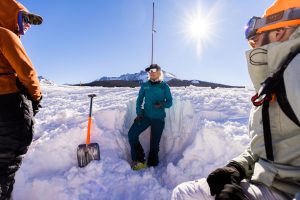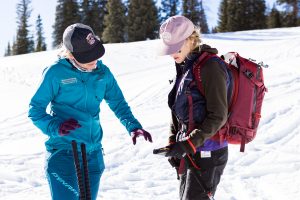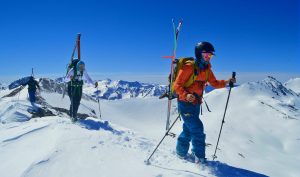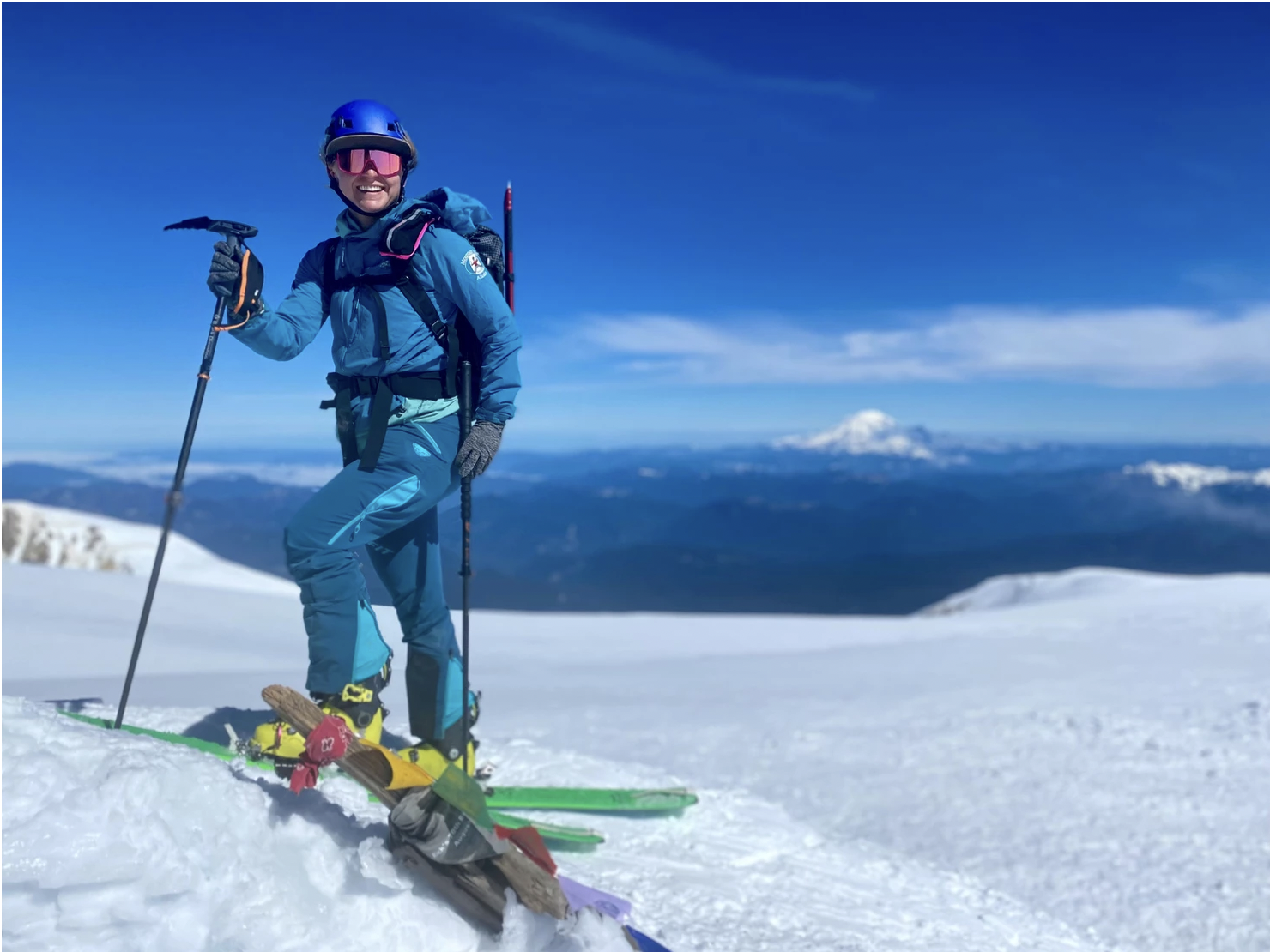Reaching Baseline for Your First Backcountry Season
with Kaylee Walden, Mountain Trip backcountry ski guide and avalanche educator
The following is an excerpt from a Mountain Trip collaboration with SheJumps, in which our female guides share their tips and tricks of the trade. Visit the SheJumps blog to read the rest of the piece and gain some insight into what Kaylee does to have a successful season in the backcountry.
What do you have in your pack for a typical backcountry tour?
There’s a baseline kit that you should have in your pack every single tour to be well prepared for a successful day.
Pack: Something in the 22-35 liter range is great for most day tours. Preferably ski specific, with straps for carrying skis and a pocket designed for your rescue gear.
Avalanche Transceiver (aka Beacon): Make sure to check your (and your partner’s) battery and search function at the beginning of every tour. I trade out batteries when they fall below 50 percent. Much lower than that, and your battery life is compromised when in search mode.

Shovel: You want your shovel to be sharp and in good condition, both for rescue and for digging snowpits.
Probe: For most snowpacks, I recommend a probe over 300 cm. Take it out of its storage sleeve before it goes in your pack to have it ready to be deployed.
Skins: You don’t need to store them on the skin saver or in the bag when you’re out for a tour. Carefully sticking them to themselves in quarters and rolling them up saves space and time. Make sure to clear off any snow before applying them, and take them out of your pack to hang-dry at the end of each day.
Water: You should actually remember to drink it, too. Bring at least a liter, or more depending on your objective. You can also swap this out for a thermos of tea on a particularly cold day.
Snacks: Obviously! But bring things that are packable, calorie dense, carb forward, and that you’ll actually want to eat. A simple peanut butter and banana wrap in a tortilla does it for me most of the time.
Ski Straps: I like to have three, of varying lengths, and I usually keep one handy. They have virtually endless uses, including keeping skins attached when they won’t stick, fixing a broken boot, or even in first aid applications, like helping to stabilize an extremity.
First Aid Kit: Remember to tweak this for backcountry skiing versus what you bring, say, mountain biking, so that it’s more specific to injuries you might encounter.
 Scraper/Skin Wax: A small, plastic scraper tool helps clear ice and snow from tech bindings so they work properly, and skin wax will keep skins gliding rather than glopping on days with big temperature fluctuations. This is more of a spring concern in some areas like the Canadian Rockies, but it can happen anytime in Colorado.
Scraper/Skin Wax: A small, plastic scraper tool helps clear ice and snow from tech bindings so they work properly, and skin wax will keep skins gliding rather than glopping on days with big temperature fluctuations. This is more of a spring concern in some areas like the Canadian Rockies, but it can happen anytime in Colorado.
Phone: Fully charged, with maps for your area downloaded, and as a rule at least 20 inches (50 cm) from your transmitting beacon.
inReach or Other Emergency Communication Device: If you’re going somewhere without cell service and outside of resort boundaries, it’s a non-negotiable to have one of these in your party.
Headlamp: Something small (like a Petzl Bindi) that lives in your pack in case you end up being out much later than intended.
Small Repair Kit: Extra skin clips, a knife or multi-tool, electrical tape, a few rubber bands, gear repair tape, and zip ties can solve a whole lot of problems and potentially save you a headache.
Packable Emergency Bivvy: The smallest one you can buy works just fine for day tours, but will make all the difference in case of emergency.
Puffy Layer: Something to throw on for warmth during breaks and transitions, while digging pits, if the weather changes unexpectedly, or if something goes awry.
Gloves: Keep ‘em waterproof by applying wax to your leather gloves each season. Bring a second, light pair for protection when you’re moving uphill and too warm for heavy gloves.
Headwear: Many people opt to ski without a helmet in the backcountry, but it’s always best to protect your head. I bring a helmet, a buff for warmth or to use as a headband, good UV-protective sunglasses, and ski goggles for the downhill.
Forecast: This is actually kept in your brain, but don’t forget to take the time during your morning coffee to check out the local avalanche forecast for the day and continue to make informed observations throughout your tour.
 Some extra items I usually have in my pack when I’m guiding or on a long mission include: rescue sled, ski crampons, boot crampons, ice axe, snow study kit, guide notebook, extra batteries, overnight gear and a rope(s). This list changes a bit if I’m skiing in the sidecountry or touring within ski resort boundaries.
Some extra items I usually have in my pack when I’m guiding or on a long mission include: rescue sled, ski crampons, boot crampons, ice axe, snow study kit, guide notebook, extra batteries, overnight gear and a rope(s). This list changes a bit if I’m skiing in the sidecountry or touring within ski resort boundaries.
To read the rest of Kaylee’s tips, click here! Mountain Trip offers both Intro to Backcountry and Avalanche Education courses for those looking to get into touring. Feel free to reach out to us for additional info!


I’d even add” phoneS. Probably one of the more useful device to begin with, so why not bring 2. Or at least extra batteries for you main one!